The Museum is regarded as contemporary and relevant to Australians and the government.
The Museum builds its profile through research, collections, exhibitions, educational programs and public events that promote lifelong learning, publications and online products. Business priorities for FY 2013–14 were:
| Business priorities | Report |
|---|---|
| 1.1 Project the Museum nationally and internationally, taking opportunities offered by a new media environment | ACHIEVED:
IN PROGRESS:
|
| 1.2 Extend the Museum’s tourism reach through partnerships, targeted promotional campaigns and strategic communication | ACHIEVED:
|
| 1.3 Focus the Museum’s collection development activities to address collection gaps and meet program needs | ACHIEVED:
IN PROGRESS:
|
| 1.4 Plan for the next stage of gallery refurbishment and refine delivery of the Museum’s temporary exhibition program | ACHIEVED:
IN PROGRESS:
|
| 1.5 Integrate research with program development, and communicate the Museum’s intellectual leadership through public programs, exhibitions and publications | ACHIEVED:
|
The Museum has the capability to drive its strategic intent.
Delivery of programs and services to the public is made possible by the Museum’s workforce, facilities, information, media and technology services, business and financial management, and executive support. Business priorities for FY 2013–14 were:
| Business priorities | Report |
|---|---|
| 2.1 Undertake workforce planning and develop leadership capabilities to support the Museum’s new structure | Achieved:
|
| 2.2 Embed a strategic focus in budget development, planning and reporting | Achieved:
|
| 2.3 Ensure the alignment of internal performance measures with cross-agency Key Performance Indicators developed by the Ministry for the Arts | Achieved:
|
| 2.4 Improve the Performance Management System (Workplace Conversations) through staff and union consultation | Achieved:
|
| 2.5 Monitor the work culture of the Museum through the Performance Management System, Museum Consultative Forum and staff survey | Achieved:
|
| 2.6 Implement the Reconciliation Action Plan | In progress:
|
The Museum has a network of partners, sponsors and champions.
Many Museum programs and services rely upon the support of and partnerships with other cultural agencies, organisations and individuals. Business priorities for FY 2013–14 were:
| Business priorities | Report |
|---|---|
| 3.1 Continue to implement recommendations of the review of fundraising as appropriate, including developing strategic partnerships | ACHIEVED:
|
| 3.2 Build partnerships through making effective use of the Client Relationship Management system | ACHIEVED:
|
| 3.3 Align with whole-of-government agendas for shared computer services, green initiatives, and the rationalisation of property and storage infrastructure | ACHIEVED:
|
| 3.4 Be a leader in the provision of education programming and curriculum materials in relation to the Australian Curriculum | ACHIEVED:
|
| 3.5 Develop partnerships that build upon, and develop, the Museum’s programs and collection strengths | ACHIEVED:
|
The Museum has current and emerging technologies in place.
New digital and information technologies enable the Museum to deliver programs and services to audiences wherever they are. Business priorities for FY 2013–14 were:
| Business priorities | Report |
|---|---|
| 4.1 Create concepts for using supplementary funding (2012–13 to 2015–16) to enhance access to the Museum’s programs and collections | ACHIEVED:
|
| 4.2 Extend the reach of the Museum’s education and learning programs through increased use of digital delivery methods | ACHIEVED:
|
| 4.3 Complete the reconceptualising of Kspace | ACHIEVED:
|
| 4.4 Review Information and Communication Technology (ICT) service delivery arrangements to assist the Museum with delivering its strategic directions | ACHIEVED:
|
| 4.5 Consolidate the implementation of the Museum’s digital collections and related asset management system | ACHIEVED:
|
The Museum has the capacity to invest in infrastructure.
Delivery of programs and services to the public is made possible by the Museum’s workforce, facilities, information, media and technology services, business and financial management, and executive support. Business priorities for FY 2013–14 were:
| Business priorities | Report |
|---|---|
| 5.1 Undertake a review of the Museum Shop’s operations with an aim to increase revenue and expand the Museum’s brand | ACHIEVED:
|
| 5.2 Increase the commercial return for the Museum through enhancing business processes and streamlining operations | ACHIEVED:
|
| 5.3 Develop innovative programs and events of wide appeal to increase venue hire and the use of facilities, including the cafe and theatre | ACHIEVED:
|
| 5.4 Build a donor base that includes regular giving, major gifts and bequests | ACHIEVED:
|
| 5.5 Source additional funding opportunities through state and federal governments | ACHIEVED:
|
